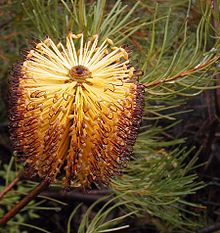Wildflower is a term used in some countries to describe the numerous showy flowers from some drier climates, most notably southwest Western Australia, Southern Africa and North America.
Natural landscaping, also called native gardening, is the use of plants, including trees, shrubs, groundcover, grasses and wildflowers, which are indigenous to the geographical area in which the garden is located, as well as rocks and boulders in place of groomed lawns and planned planting beds to blend residential or commercial property into the natural surroundings of the particular area.
In theory, natural landscaping is adapted to the climate, geography and hydrology and should require no pesticides, fertilizers and watering to maintain, given that native plants have adapted and evolved to local conditions over thousands of years. However, these applications may be necessary for some preventative care of trees and other vegetation.
Native plants suit today's interest in "low-maintenance" gardening and landscaping, with many species vigorous and hardy and able to survive winter cold and summer heat. Once established, they can flourish without irrigation or fertilization, and are resistant to most pests and diseases.
 Many municipalities have quickly recognized the benefits of natural landscaping due to municipal budget constraints and reductions and the general public is now benefiting from the implementation of natural landscaping techniques to save water and create more personal time.
Many municipalities have quickly recognized the benefits of natural landscaping due to municipal budget constraints and reductions and the general public is now benefiting from the implementation of natural landscaping techniques to save water and create more personal time.
Bush regeneration shares many similarities, though it targets preexisting patches of (often heavily degraded) original bushland and has removal of weeds as a high (sometimes higher) priority than replanting of native plants.
Native plants provide suitable habitat for native species of butterflies, birds, and other wildlife. They provide more variety in gardens by offering myriad alternatives to the over-planted cultivars and aliens. These plants have co-evolved with animals, fungi and microbes, to form a complex network of relationships. They are the foundation of their native ecosystems, or natural communities.
Winter garden
- This article is regarding the kind of garden maintained in wintertime; for other meanings, see Winter Garden
A winter garden is, as the name implies, a garden planted either to produce food, or at least to remain visibly planted and slowly develop, throughout the winter, or else a garden whose plants will serve as living decoration all winter.
Vegetables that are typically, or can be, used in a winter garden include:
- Several breeds of winter hardy cabbage
- Certain winter-hardy breeds of broccoli
- Winter rye is even grown where a summer garden will be, in order to protect the ground from weeds, and provide soil amendment when tilled directly into the soil the following spring
- beets
- carrots
- alliums -- onions, chives, and their relatives are evergreen, though some may die back during the winter and recover in the spring.
- oregano (including marjoram) -- known to hardily survive the winter up to Zone 5
One basic premise, in temperate or colder regions, to the winter garden is that the plants may indeed become dormant when snow covers the ground, but will grow each time the sun heats at least part of the plant to above freezing (snow or not), especially in regions where snow cover and below-freezing temps are not constant for months at a time. Perhaps the most famous "winter garden" is at the Biltmore Estate near Ashville, North Carolina.






No comments:
Post a Comment